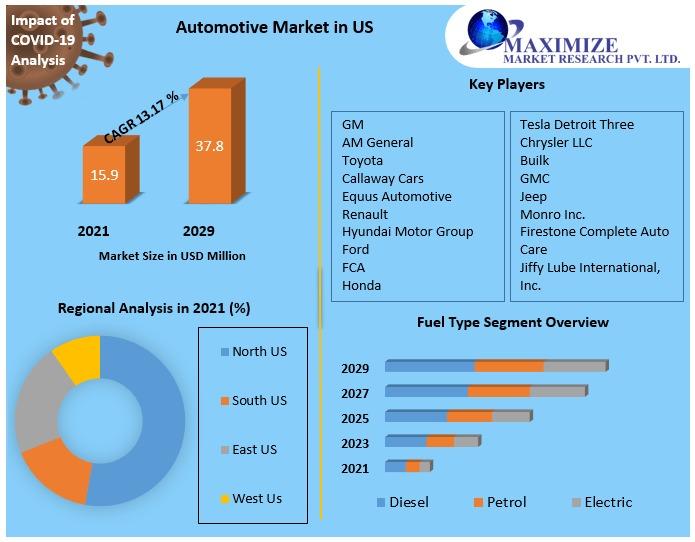Subheading
The US automotive market is set to expand rapidly through 2029, fueled by rising EV demand, advanced technologies, and growing urban mobility trends.
Opening Paragraph
According to a new industry report by Maximize Market Research, the US automotive market was valued at USD 15.9 million in 2021 and is projected to reach USD 37.8 million by 2029, registering a robust compound annual growth rate (CAGR) of 13.17% during the forecast period from 2022 to 2029. The market’s growth trajectory reflects the accelerating transition toward electric vehicles, heightened consumer expectations for safety and comfort, and the growing volume of miles driven nationwide.
For full access to the data, request a sample report now : https://www.maximizemarketresearch.com/request-sample/86405/
Key Highlights
Market Size: USD 15.9 million in 2021 → USD 37.8 million by 2029
Growth Rate: CAGR of 13.17% (2022-2029)
Leading Segment: Three-wheeler vehicles hold the largest market share
Dominant Fuel Type: Petrol segment leads, followed by growing EV penetration
Top Regions: California and Washington represent leading state markets
Growth Drivers: Vehicle electrification, urbanization, higher VMT (vehicle miles traveled), and technology integration
Restraints: Raw-material inflation, supply-chain constraints, and regulatory challenges
Key Players: Toyota Motor Corporation, General Motors, Ford Motor Company, Tesla, Hyundai, and Honda
Market Outlook
The US automotive market is entering a dynamic phase of transformation, driven by the convergence of electrification, connectivity, and evolving mobility patterns. The industry’s value is forecast to more than double between 2021 and 2029, supported by strong consumer demand and increasing innovation across every segment-from passenger cars to commercial and three-wheel vehicles.
Electrification remains the single most significant driver. Federal and state initiatives promoting clean energy, along with rising fuel prices and environmental awareness, are propelling electric vehicle (EV) sales. Consumer sentiment has also shifted, as buyers now view EVs as viable alternatives offering both performance and sustainability.
Technology adoption further supports this transformation. Automakers are investing heavily in ADAS (advanced driver assistance systems), connected infotainment platforms, telematics, and smart sensors to enhance vehicle safety and comfort. These advancements not only elevate the driving experience but also drive recurring service and maintenance demand-boosting the aftermarket segment.
Meanwhile, the growing number of miles driven annually, combined with a rising vehicle population, underscores the sustained need for automotive services, tires, batteries, and related components.
Growth Drivers
1. Electrification Momentum
The electrification trend is reshaping the entire automotive ecosystem. Declining battery costs, expansion of charging infrastructure, and government incentives are lowering barriers to EV adoption. Automakers are accelerating EV production capacity, while traditional internal-combustion models are being gradually phased out or hybridized.
2. Urbanization and Mobility Evolution
Increasing urbanization, coupled with rising disposable incomes, has led to higher vehicle ownership rates in metropolitan areas. Simultaneously, shared-mobility services, ride-hailing, and subscription models are diversifying revenue streams across the mobility ecosystem.
3. Advanced Technology Integration
Modern vehicles now incorporate extensive electronics, software, and connectivity systems. Technologies such as adaptive cruise control, collision avoidance, lane-keeping assist, and digital instrument clusters have transitioned from luxury to mainstream segments.
4. Aftermarket Expansion
As the US vehicle fleet ages and diversifies, demand for repair, maintenance, and upgrades continues to rise. This includes replacement tires, batteries, brake systems, and electric-vehicle-specific components such as power electronics and charging modules.
Challenges and Restraints
While prospects are strong, the market faces several structural challenges:
Rising Raw-Material Costs: Inflation in copper, steel, and plastics has increased manufacturing costs by up to 40% in some categories.
Supply-Chain Disruptions: Semiconductor shortages and logistical bottlenecks continue to impact production schedules and delivery timelines.
Regulatory Complexity: Stricter emission standards and state-level policy variations can complicate compliance and add operational overheads.
Price Sensitivity: Advanced technologies, while in demand, increase vehicle cost-potentially constraining mass-market adoption in the short term.
Segment Analysis
By Vehicle Type
The market is segmented into passenger cars, commercial vehicles, three-wheelers, and two-wheelers. Among these, the three-wheeler segment held the largest share in 2024, accounting for nearly 79% of market volume. These vehicles serve crucial roles in short-distance transportation, delivery, and urban mobility services.
Passenger cars represent the most dynamic category in terms of technological innovation and EV adoption, while commercial vehicles benefit from fleet electrification and logistics growth.
By Fuel Type
The market is divided into petrol, diesel, and electric segments. The petrol segment currently leads with approximately two-thirds of total revenue, although electric vehicles are the fastest-growing category. Increasing investment in charging networks and improved battery performance are expected to narrow this gap by 2029.
By Service Type
Services are grouped into mechanical, exterior & structural, and electrical & electronics. The latter segment shows the highest growth rate due to the proliferation of electronic systems in modern vehicles and the increasing need for software diagnostics and calibration.
By Equipment Type
Automotive equipment includes tires, seats, batteries, and miscellaneous components. Battery demand is expected to soar in line with EV adoption, while tires and seating systems remain resilient categories driven by replacement cycles and comfort upgrades.
Regional Insights
The report highlights the varied landscape across the United States. California leads the national market with a share exceeding 25%, primarily due to strong EV incentives, advanced infrastructure, and consumer preference for sustainable mobility. Washington State follows with roughly 15%, supported by a thriving clean-tech economy.
Other states are catching up as they invest in EV charging stations, emission-free public fleets, and digital mobility solutions. Urban regions are poised to benefit most from mobility-as-a-service platforms and autonomous testing zones, while suburban and rural markets continue to sustain strong demand for conventional vehicles.
Unlock more insights-request a free sample report now : https://www.maximizemarketresearch.com/request-sample/86405/
Key Players and Competitive Landscape
The US automotive landscape features a blend of legacy manufacturers, emerging EV specialists, and robust aftermarket players. Leading participants include:
Toyota Motor Corporation – Expanding its hybrid and hydrogen-fuel lineup.
General Motors (GM) – Aggressively scaling EV production under its “Ultium” platform.
Ford Motor Company – Investing in EV trucks and autonomous technologies.
Tesla, Inc. – Market leader in electric mobility and software-driven ecosystems.
Hyundai Motor Group – Innovating in battery technology and fuel-cell applications.
Honda Motor Co., Ltd. – Advancing hybrid-electric and next-generation combustion engines.
In the service sector, companies such as Monro Inc., Firestone Complete Auto Care, Jiffy Lube, and Meineke Car Care Centers dominate the aftermarket landscape. Their ability to adapt to EV maintenance requirements and offer advanced diagnostic capabilities will determine long-term competitiveness.
The competitive environment is evaluated using Porter’s Five Forces, PESTEL, and value-chain analyses, providing insights into supplier power, buyer dynamics, market entry barriers, and strategic alliances.
Emerging Trends and Opportunities
Electric Vehicle Infrastructure Expansion – Government and private investment in charging networks will catalyze EV adoption and battery supply-chain development.
Connected and Autonomous Vehicles – Integration of IoT, 5G, and AI will enable over-the-air updates, predictive maintenance, and safer autonomous systems.
Sustainable Manufacturing – Automakers are transitioning to recyclable materials, renewable energy sources, and carbon-neutral production plants.
Mobility-as-a-Service (MaaS) – Subscription-based and shared mobility models will transform vehicle ownership and fleet composition.
Aftermarket Digitization – Predictive analytics and connected diagnostics will enhance vehicle servicing, creating new growth avenues for maintenance providers.
Future Outlook
Looking ahead, the US automotive market is expected to maintain double-digit growth through 2029. The shift from traditional combustion to electric and hybrid vehicles will redefine supply chains, manufacturing priorities, and aftermarket ecosystems.
The market’s evolution will depend on three critical success factors: technology adoption, policy alignment, and consumer acceptance. Automakers that invest early in electrification, software, and sustainability are likely to capture significant market share. Meanwhile, after-sales and mobility services will emerge as high-margin opportunities in an increasingly connected and data-driven industry.
Interested in detailed insights? Inquire for a sample report : https://www.maximizemarketresearch.com/request-sample/86405/
Related Reports :
Global Vibration Damper Market https://www.maximizemarketresearch.com/market-report/global-vibration-damper-market/10859/
Global Automotive Seat Belt Reminder Market https://www.maximizemarketresearch.com/market-report/global-automotive-seat-belt-reminder-market/105167/
Global B2B Mobility Sharing Market https://www.maximizemarketresearch.com/market-report/global-b2b-mobility-sharing-market/75002/
Global Trade Compliance Systems Market https://www.maximizemarketresearch.com/market-report/global-trade-compliance-systems-market/94897/
Global Railcar Leasing Market https://www.maximizemarketresearch.com/market-report/global-railcar-leasing-market/121308/
Contact Us :
MAXIMIZE MARKET RESEARCH PVT. LTD.
2nd Floor, Navale IT park Phase 3,
Pune Banglore Highway, Narhe
Pune, Maharashtra 411041, India.
+91 9607365656
About Us :
Maximize Market Research is one of the fastest-growing market research and business consulting firms serving clients globally. Our revenue impact and focused growth-driven research initiatives make us a proud partner of majority of the Fortune 500 companies. We have a diversified portfolio and serve a variety of industries such as IT & telecom, chemical, food & beverage, aerospace & defense, healthcare and others.
This release was published on openPR.


